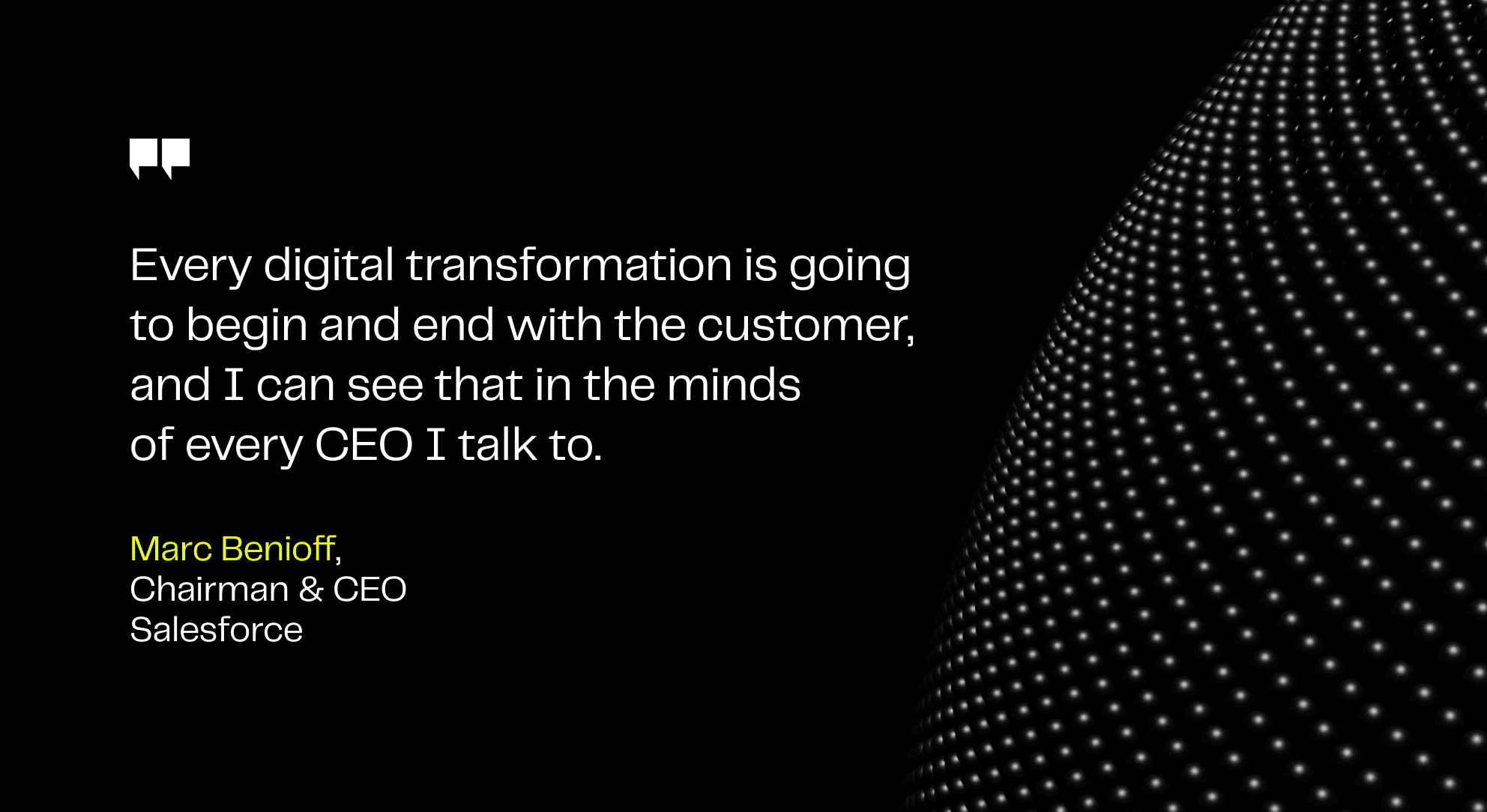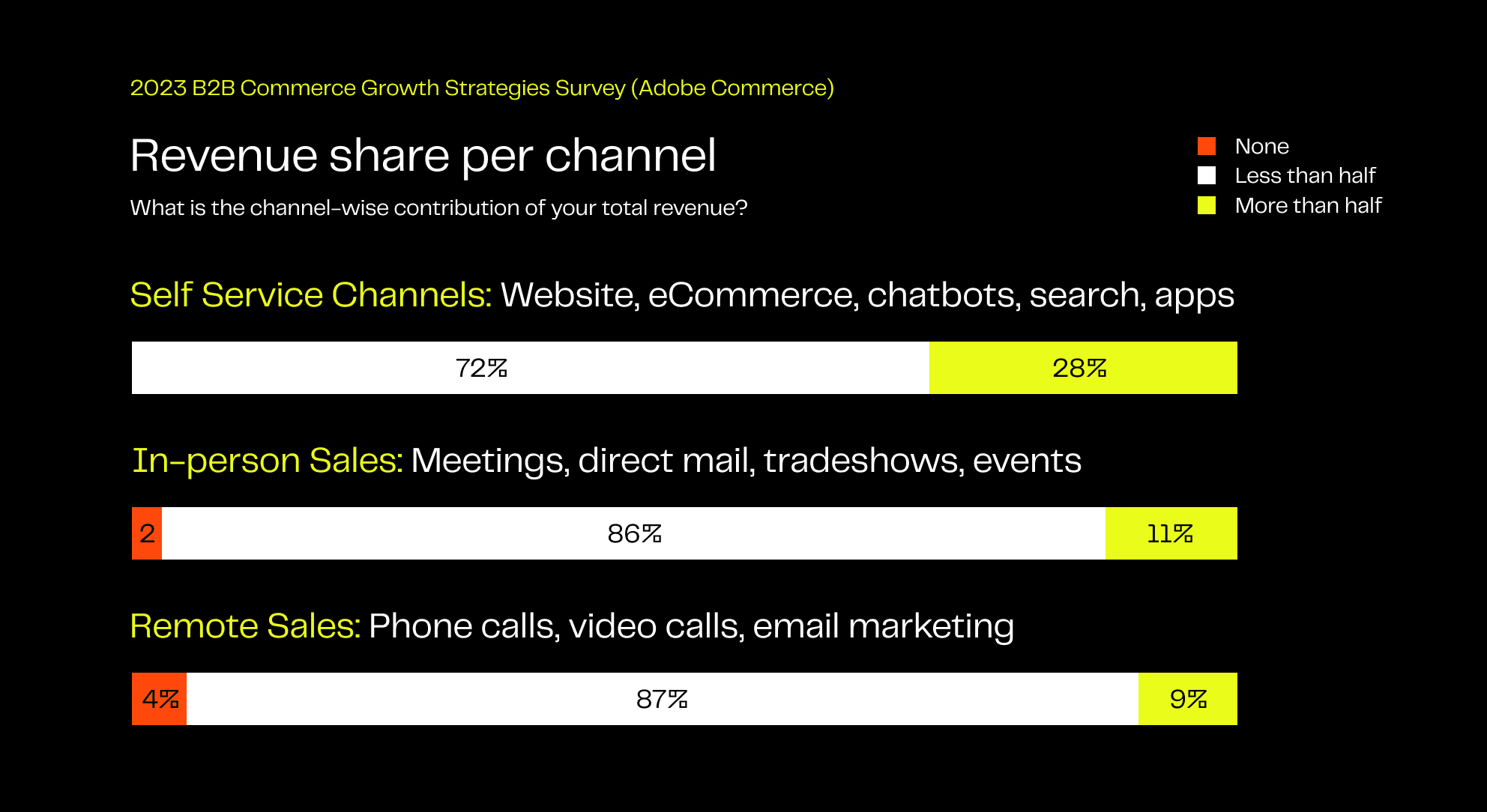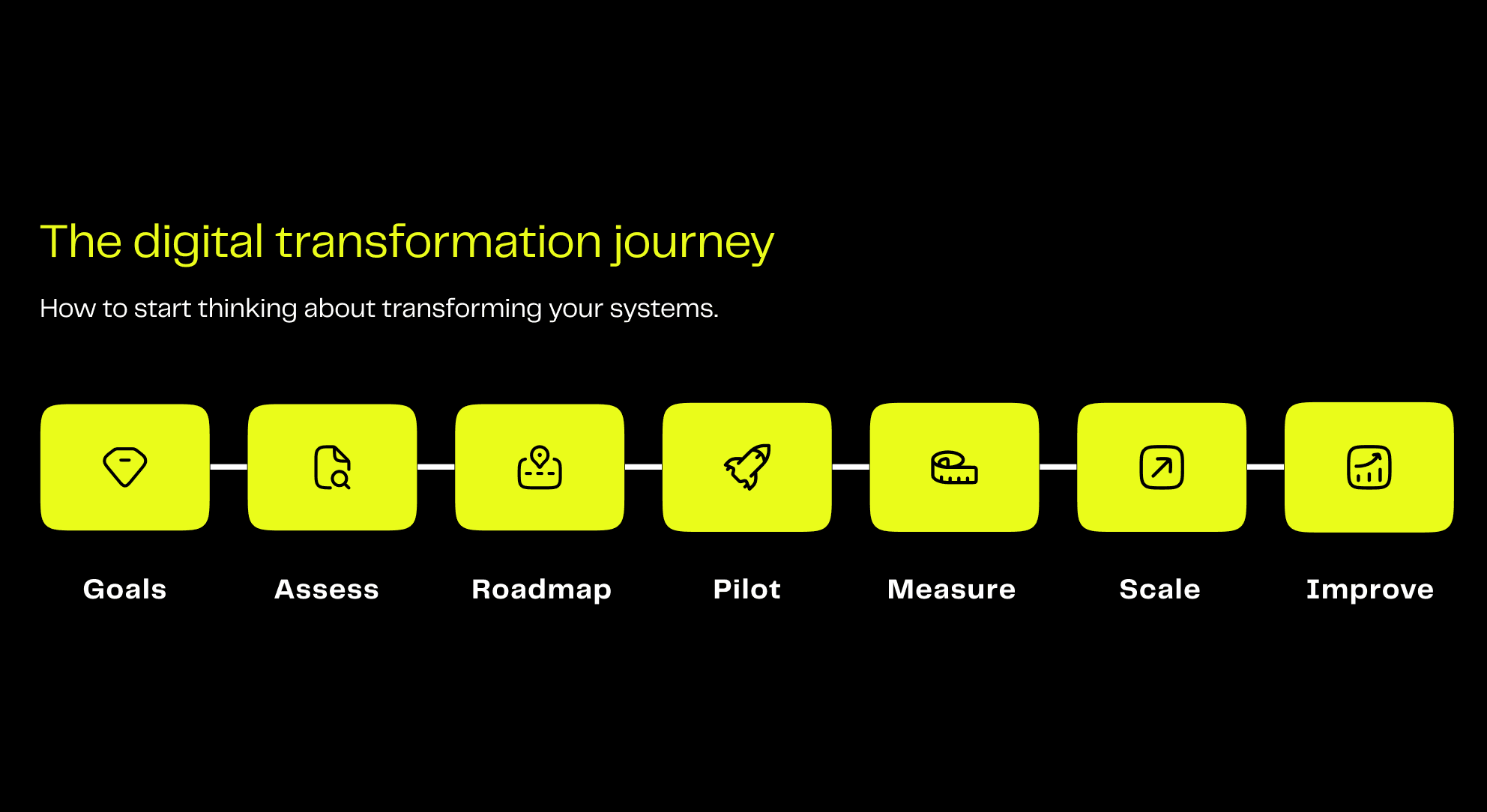Beyond The Buzzword: How We Approach Digital Transformation
Digital transformation is not just a buzzword anymore—it's a present-day reality that determines how businesses survive and thrive in an increasingly complex market. But despite this reality, the term has become so diluted (thanks to ISVs) that its real meaning slips through the cracks.
Here’s how we see it—transforming your systems isn’t about chasing every new tech trend or adopting trending technology for its own sake.
At its core, it should reshape how your company operates—not only by enhancing customer experiences but also by fundamentally improving business processes and decision-making.
To simplify this further, here’s a 4W1H framework that we use to help enterprises anticipate, validate, and activate their internal digital transformation.
- When should you start thinking about transformation?
- Why do you need to reimagine your architecture?
- Who should lead this effort, internally and externally?
- Where do you start?
- How do you set goals, plan progress, and measure outcomes?
When should you start thinking about transformation?
To stay competitive in an increasingly digital-first world, the answer is clear: the time is now.

Speak to your customers
Expectations have evolved—today’s consumers seek personalized, effortless experiences that seamlessly integrate into their lives. Industry leaders like Amazon have set new benchmarks in convenience and personalization, and customers carry these expectations to every brand they engage with.
If you’re seeing declining customer satisfaction scores or receiving feedback about outdated or clunky processes, it's a clear sign that your current setup is not meeting modern expectations.
Study category leaders and competitors
Assess your market position – both within your category and among competitors.
Competitors, especially agile startups, are likely to use newer technologies to improve efficiency, streamline operations, and capture market share. If they’re outpacing you, it's another sign that conventional approaches may no longer be enough.
- Benchmark against category leaders to better understand their strategies
- Perform gap analyses to identify where your systems fall short
- Engage in regular competitive intelligence to track changes in market share, client wins, or product development
Assess your technology stack
Finally, consider your technology stack.
Enterprises accumulate a suite of tools over time, but, without a cohesive strategy or orchestration, these often work in silos, leading to missed opportunities. Some common symptoms include:
- Data scattered across disparate systems
- Teams that don’t have visibility across functions
- An inability to leverage analytics and automation for growth
If these problems sound familiar, you’re likely leaving serious value untapped. Ask yourself these questions:
- Are customers expressing dissatisfaction with your services?
- Do you lack real-time visibility in your operations?
- Is your data scattered across systems, hindering actionable insights?
- Are you slower to market compared to your competitors?
- Is your current stack propelling you forward or holding you back?
- Do you see a rise in churn due to perceived inefficiencies?
If your answer to any of these is a ‘yes’, it’s time to prioritize digital transformation.
Why do you need to reimagine your architecture?
Legacy systems are becoming more of a burden than a benefit.
Outdated frameworks lack the flexibility to support real-time data, omnichannel engagement, and scalable operations—limitations that can stifle growth and hold companies back.
This is underscored by current trends – a 2023 B2B Commerce Growth Strategies Survey by Adobe Commerce revealed that 63% of B2B ecommerce companies were investing in user experience improvements through personalization, recognizing its impact on customer engagement. While 72% of B2B organizations collected behavioral and transactional data and 68% used it for personalization on their websites, fewer were integrating these insights across systems like marketing, inventory, and order history.

This limitation hinders the ability of enterprises to deliver the advanced, hyper-tailored experiences that B2B customers increasingly expect.
Let’s look at another example.
Al Ghandi, a leading GCC-based distributor of industrial electrical components, recognized other operational challenges firsthand. Their traditional, resource-heavy order processes were creating bottlenecks that delayed deliveries and limited growth potential.
To overcome these challenges, AI Ghandi moved from legacy systems to a modern, cloud-based infrastructure that digitally streamlined the purchasing journey end-to-end. This new architecture enabled 95% of Al Ghandi’s customers to transition to online ordering, slashing average order processing times by 10 days.
Within a year, Al Ghandi doubled its customer base, setting an industry benchmark for speed, accessibility, and transparency in B2B commerce.
Who should lead this effort, internally and externally?
A successful transformation effort hinges on strong, multifaceted leadership.
In our experience, while the C-Suite (typically the CTO/CIO) defines the transformation agenda to set high-level goals, budgets, and strategic priorities — effective change requires more than top-level direction.
As Brian Hopkins, principal analyst at Forrester, puts it, “In the future, there’s going to be one or a set of tech executives responsible for moving business forward—not necessarily the CIO.”
Our consultants routinely collaborate with Directors and VPs from technology, IT, and marketing as they take the reins on day-to-day progress, translating high-level goals into concrete actions. Along with a Head of Transformation, they oversee and coordinate efforts, driving cross-departmental alignment, continuity, and measuring impact.
This distributed leadership model keeps the effort agile, ensuring that every function—from operations to customer experience—benefits from cohesive, well-executed changes.
The role of external partners
External partners bring specialized expertise to tackle complex challenges efficiently. They:
- Provide tested frameworks, minimize trial-and-error, and optimize resources
- Highlight missed opportunities and challenges, offer a fresh external perspective
- Empower teams with best practices, for sustainable maintenance and management
When you’re selecting an external partner, we recommend considering:
- Proven Track Record: Look for partners with a history of success in enterprise e-commerce and expertise in areas like supply chains, omnichannel strategies, and customer data integration.
- Cultural Fit: Partners who align with your company culture collaborate more effectively and are better suited to support your long-term goals.
- Collaborative Approach: The best partners enable internal teams, ensuring knowledge transfer and empowering your talent.
- Strategic Alignment: Ensure the partner is invested in your long-term success and aligns with your overarching objectives.
Finding the right digital transformation partner is crucial in an increasingly competitive landscape, so we recommend investing time in this endeavor.
Where do you start?
Transformation isn't a mandate to digitalize every facet of your operations.
It is just the vehicle— and the true goal is to leverage tools where they deliver the most impact, whether that’s enhancing the customer experience, improving supply chain agility, or streamlining backend processes.
Apply the time-tested 80/20 rule – identify critical and strategic areas where small, targeted adjustments can drive outsized results.
For instance - take Nike’s approach to tackling supply chain inefficiencies.
With inventory visibility issues affecting stock levels and sales, they implemented an ERP system with real-time analytics. The impact? A 7% lift in global sales and a 30% drop in stockouts. By zeroing in on a single, high-impact area, Nike achieved substantial gains without unnecessary disruption.
Here’s what we recommend:
- Listen to Your Customers: Identify where customer satisfaction may be slipping—whether due to slow deliveries or inconsistent experiences. Addressing these issues can quickly enhance loyalty.
- Address Operational Bottlenecks: Pinpoint inefficiencies that limit responsiveness, like outdated processes or inventory visibility challenges. Often, these challenges go unnoticed but can carry a significant impact on performance.
- Align with Your Business Goals: Choose initiatives that support long-term objectives, like expanding into new markets or boosting customer retention.
- Define and Track Key Metrics: Tie KPIs directly to business goals, such as customer satisfaction (NPS, retention), internal efficiency (order fulfillment times, inventory turnover), and growth metrics (conversion rates, average order value).
- Balance Leading and Lagging Indicators: Use leading indicators (customer engagement, website traffic) for proactive adjustments, while lagging indicators (revenue growth, profit margins) offer a comprehensive view of impact. This balanced approach allows for timely, data-driven decisions.
How do you set goals, plan progress, and measure outcomes?
In our experience, digital transformation is a structured journey that requires a clear, step-by-step roadmap to align teams, minimize disruption, and deliver measurable results.

Here’s the five-step roadmap we use to guide clients through their transformation journey:
Step 1: Define Measurable Objectives
Transformation should generate sustainable value beyond quick wins.
Start by setting objectives that align with long-term goals. For instance, if your focus is expanding in high-growth regions, prioritize regional logistics and customer insights. If customer lifetime value (CLV) is the goal, center your strategy on personalized experiences and data-driven segmentation.
Anchoring transformation goals to key metrics, such as cost reductions or retention improvements, ensures each step delivers meaningful results.
Step 2: Assess the Current State to Identify Opportunities
Identify what’s holding back progress—inefficiencies, data silos, or technology gaps that impact responsiveness and customer satisfaction. For example, assess real-time data access and cross-channel integration in global operations.
Pinpointing these operational and customer-facing bottlenecks clarifies where transformation can make the most impact.
Step 3: Develop a Sequenced Roadmap
Once priorities are set, we create a phased roadmap that minimizes disruption and builds momentum with early wins. For instance, begin with foundational work like unifying data systems, then proceed to customer personalization and process automation.
This sequenced approach allows flexibility, enabling you to adapt to new insights and challenges as you progress.
Step 4: Build and Measure Success of Pilots
Running POCs before full deployment allows you to test solutions on a smaller scale. The purpose of a pilot is twofold:
- Ensure the technology works within your business context.
- Track meaningful metrics to assess value.
For example, piloting a predictive analytics tool to optimize regional inventory levels may improve cash flow management and enhance supplier relationships through better demand forecasting.
Similarly, testing an AI-driven personalization engine can refine customer engagement, optimize product offerings, and implement dynamic pricing.
To ensure pilots drive tangible results, establish success metrics such as:
- Operational Metrics: Reduced order processing time, improved fulfillment accuracy, or logistics cost savings.
- Customer Metrics: Increased engagement, higher conversion rates, or improved customer satisfaction scores.
- Financial Metrics: Revenue growth, enhanced profit margins, or reduced operational costs.
These metrics provide actionable data to inform whether the solution is ready to scale across the organization.
Step 5: Scaling and Continuous Improvement
Once a pilot proves successful, deploy it organization-wide. For instance, if an AI-driven personalization tool performs well for a specific segment, expand its use across other relevant customer groups. Ensure that your infrastructure can support the broader implementation without needing extensive reconfiguration.
Secondly, continuously monitor performance and make adjustments based on real-time data. By tracking set KPIs you can identify areas that need fine-tuning or further optimization. This keeps your business agile and ready to adapt to emerging trends and technologies.
For instance, as consumer behaviors shift or new competitors enter the market, your e-commerce strategy may require updates to personalization engines, fulfillment processes, or supply chain optimization techniques.
Regular reviews of performance data, combined with an openness to new innovations, will keep your enterprise at the forefront, and ahead of the curve.
Interested in learning how we can assist your digital transformation journey? Contact us at hello@coderapper.com to arrange a consultation.







